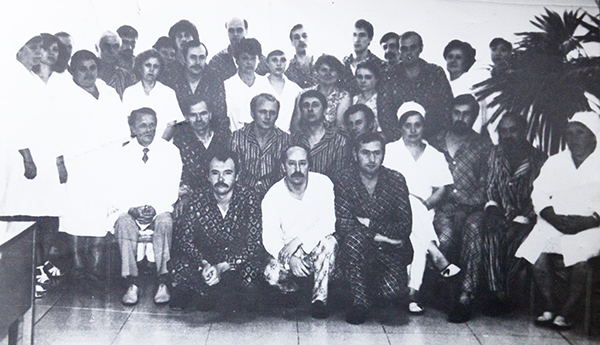Yurii Shcherbak‘s first major literary work ‘Chernobyl‘ was published in the USSR in 1986 already. Starting the following year, it was translated into many languages and published in the US, Canada, Germany, Poland, Switzerland, Japan, and other countries worldwide. Here is how the author describes the event at the Kyiv Hospital that took place the very next day after the catastrophe: “Maksym Ivanovych Drach, twenty-two years old, sixth-year student in the medical faculty of the Kyiv Medical Institute:
‘I first heard about the accident on Sunday morning, 27 April. I work in the resuscitation block of the cardiological center in the October Revolution Hospital. I work as a medical assistant. A senior one, wherever they send you. I came on duty at nine in the morning. At half past nine one woman (her husband is an internal service major) said: “They’ve taken my husband off somewhere, like some nuclear station has blown up, but I think it’s a joke.” But at midday, we were telephoned and told, in connection with the accident at the Chornobyl nuclear power station, to prepare, together with the General Resuscitation Department, forty beds on the fourth floor. Our block is on the second floor. I went up to the fourth to prepare the department. The patients were transferred to other departments, the beds were changed, all the medicines were prepared, blood substitutes and so on. No one knew what we were going to have to deal with. ‘At 6 pm we were told that the first patients from Prypiat were already at the disinfection center. We went to receive them: our duty doctors, from the Department of Radioactive Isotopes Diagnostics and General Resuscitation. We looked at them. They were primarily young fellows: firemen and workers at the nuclear power plant. At first, they went upstairs with their things, but then a frightened dosimeter operator doctor rushed in and shouted: “What are you doing? You’re ‘glowing’!” ‘They were all taken down, measured, and led off to wash not in the Disinfection Center but in the Radioactive Isotopes Diagnostics Department, where all the water was collected in containers and taken out. That was sensible, because that way the disinfection center wasn’t polluted. They were given our work pyjamas and, dressed like that, they were led upstairs…
There were twenty-six in the first group. I went upstairs to them. ‘We didn’t ask them many questions; it wasn’t the right moment. They· were all complaining of headaches and feebleness. The headaches were such that one fine two-meter fellow was standing there banging his head against the wall and saying: “That’s better, that way my head hurts less. ” ‘Well, we at once began blood disinfection procedures on them, giving glucose transfusions. We put them all immediately on a drip, organizing it all well…”
Professor Leonid Petrovych Kindzelsky and I came to the department. The professor consulted the students, examined their medical histories, and studied the results of their blood analyses. Later Maksym Drach was to meet Doctor Gale, who visited Kyiv at the beginning of June.”
Eleven firefighters from the same Pravik team were treated in Kyiv. All of them lived thanks to the Kyiv doctors and the method Dr. Kindzelsky dared to use.
In Moscow, the doctors followed the method of Dr. Gale which included the bone marrow transplantation. Out of 13 firefighters, only two survived.
